« January 2010 |
Main
| March 2010 »
 February 25, 2010 | Apps for Learning Notation
February 25, 2010 | Apps for Learning Notation
This week's tips column comes from Staff Researcher Charlie Jones, a simpatico who shares the joys of pursuing mando knowledge and is more than happy to weigh in with his thoughts on this site once in a while. Perhaps not unlike many of you, he's been struggling with learning notation late as an adult, but he's uncovered some valuable iPhone/Touch tools and practice suggestions to help in this journey. We wanted to share these with you.
Apps for Learning Notation
Charlie Jones, JazzMando Staff Research Assistant
Every few months I ponder the task of learning to read standard notation for the mandolin. Sadly though, either my motivation fades or family and work commitments get in the way. I recently picked up a copy of Mel Bay's J.S. Bach for Mandolin and after learning a couple of the easy pieces from the provided TAB I was hooked. Bach is just plain fun to play and it offers a nice retreat from a daily diet of fiddle tunes. It didn't take long to find my motivation; the music I want to play (jazz standards and classical) lives in the realm of standard notation. Yes you can find or create TAB, but I've decided that the time and effort spent doing so could be applied to learning notation. Like most long-term projects I tackle, I set out to find some tools to help me succeed. First up was something to help me structure my playing time and keep me focused. After some searching, I stumbled onto an iPhone/iPod Touch application called Practica. Practica is allows the student to create a practice schedule and to keep track of what you've worked on. The student enters their lesson, assignment or tune into the schedule. Practice then keeps track of the time spent on each of the entries in the practice schedule. You can then go back and see how much time you've spent on each component. Practica also assigns a major and minor scale to work on each day (I use FFcP Major and Minor Mandology for the chosen keys). In short, Practica is a practice log that makes it easy to track your progress. Practica also includes a metronome and then enter notes for each practice session. I usually enter tempos and progress information into these notes. Lastly, Practica has the ability to record audio, which can be helpful in tracking your progress on a particular piece.
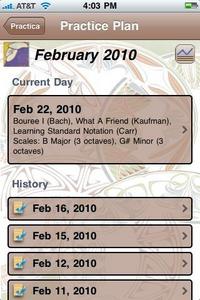 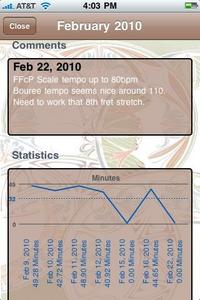
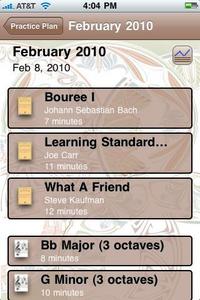 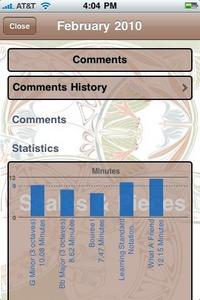
Another app I found for the iPhone/iPod Touch is iReadMusic. iReadMusic is basically a flash card type application for learning to read standard notation. There are several modes, but I prefer the "Play That Note" mode. In this mode the student sees a mandolin fretboard on the bottom of the screen and a notation staff on the top. A note appears on the staff and the student has to find it on the fretboard. The concept is simple enough, but iReadMusic gets some critical details right. It's quite configurable in terms of the notes it chooses. This allows you to tailor the application to what ever notation instructional method you are using. Most methods are incremental; they start with a small set of notes and progressively add to that base. iReadMusic allows you to configure the app to match where you are in your method. The application also scores your performance based on time and accuracy. If you are the least bit competitive, you'll find yourself repeatedly trying to beat your high score. If you have your iPhone and a few minutes to spare, you can practice your reading skills anywhere. Family, work and personal commitments keep my schedule pretty tight and it's amazing how much time I can find in the "cracks" to use this app. It's really been helpful in progressing towards my end goal.
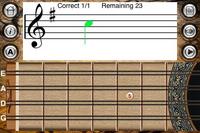 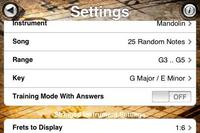
Lastly, the "analog" tools. In addition to my notation method, I picked up a couple of Mel Bay's Student Violinist books. Specifically the Bach and Beethoven books. They offer melodies that are familiar to the ear and easy to find on the fretboard. Most of the tunes in these books are in the keys of G, D and A. The trick is to match up the pieces with where you are at in your notation method.
Charlie Jones
Product Purchase Information:
Practica
iReadMusic
Further:
Debora Chen; Standard Notation for the Tab-Addicted Mandolinist
January Fitness
Practice Regime; A Balanced Diet
iReal Book
Fretboard iPhone App
Posted by Ted at 3:46 PM
 February 18, 2010 | Freshening up
February 18, 2010 | Freshening up
Jesse writes, "I have been playing mandolin for about 4 years and feel like I am progressing well, but I feel like my playing is becoming stagnant and I am not achieving the full potential I am capable of. Do you have any advice or training that you could share with me? It would be much appreciated."
Authors call this "writer's block," athletes call it a "slump," and poets call it being "abandoned by the muse." The lack of inspiration, desire for a change of scenery, or just the physical block from any kind of improvement, we all eventually run into a plateau or temporary wall. At least we hope it's temporary...

We don't know Jesse's complete situation, but the fact that he's been at it 4 years, AND he's pro-actively addressing the need by writing in tells us he considers himself an active learner. We'll make the assumption he's needing some kind of direction, whether it's a new frontier in a music style, or simply a way to continue continue the climb to better ability, we'll make a few suggestions that might be of interest for other mandolinist attuned to checking their pulse once in a while.
- Listening. Perhaps the best external stimulus comes from hearing the accomplished work of other musicians. Occasionally intimidating, more often inspiring, a performance or a good recording is an opportunity to look into another artist's mind. It's not about copying licks, it's unraveling the process. "Why did he move up the neck in that spot? Why did she use a flatted 5th in that measure?" These are the materials we can use in developing our own (hopefully) evolving language.
- Balancing calisthenics with repertoire. Practicing is like eating, you need a healthy balance of fruits and vegetables (warm-ups) with your main course and dessert. Every serious practice session should include some finger and picking development exercises along with your "literature" or song list. Injecting exercises that make you think, like calling out keys or scale degrees can help relate the two, especially if one of your goals is effective improvising.
- Noodling. There is nothing wrong with sitting in front of a TV and mindlessly playing once in a while. Relaxing and getting into the zone subconsciously is part of playing, and a good break from the discipline of formal learning. This is one of the fun things about auditioning new instruments, it forces you to recall things you've acquired long ago. Also, the "all work and no play" thing. Why do we call it "playing," anyway?
- New vocabularies. Scales and modes are like learning the words to new languages. They aren't (and shouldn't!) be the be-all and end-all to playing; they should be the start. Learning these note relationships and spreading them up and down the fretboard can be what makes a good player great.
- Sight reading. You TAB readers are tired of hearing this, but you can't overlook the last three centuries of good literature for expanding your playing. Bach is especially good because of the thoroughness of his harmonic implications. Sitting down with a good Choro book, or even reading off some unfamiliar Fiddle Tunes. It's all good.
These suggestions may not address the specific physical needs of Jesse's concerns, but they are broad strokes any player should identify and strive for in his/her personal mando development.
Have at it...
Further:
Are you improving?
On Perfection
Don Stiernberg on Mindful Noodling
10,000 hours? Discipline... in moderation.
Start your day out with a song
Posted by Ted at 3:04 PM
 February 11, 2010 | Calisthenics and mandolins
February 11, 2010 | Calisthenics and mandolins
"If you are new to the whole FFcP approach to learning the fretboard, be content that the early stages of understanding will start at this primitive level. You are developing a tactile memory, which over time will become something to build your intuition on. The cerebral part, the music theory might be overwhelming now, but over time it becomes subliminal recognition. The cognitive world of 'hunch,' 'premonition,' or even 'feeling.'"
We wrote about this phenomenon last summer in our article "Math, eggs, and mandolins; higher level understanding." The topic comes up routinely from many newly initiated into JazzMando world. The eight pages out of the "Getting Into Jazz Mandolin" of "Ionian Mandology" as well as the subsequent spin-off exercises in our free FFcP downloads can be a huge physical challenge, especially for the 3rd and 4th fingers.
One of our readers recently asked the question, "Do I need to memorize these exercises before moving on to the rest of the book?" In other words, should one try to master these exercises prior to digging deeper into the materials? The answer is pretty much "yes."
We suggested taking a few months to get familiar with them, at least close to committing them to memory. These become an essential pathway to gripping (pun intended) the physical nature of the rest of the book. It's an important part of the ultimate time table of learning the cerebral side of the materials, so you should expect to spend proportionally longer on these than anywhere else in the book. They are so important that even after they are "mastered," you'll want to incorporate them into your regular warm-up activity--for years!
Tips Summary:
- Use a metronome.
- Repeat signs are not arbitrary. Repeat the selections within these bars as often as you need to make them comfortable. You can't overplay them!
- Tempo is determined by how fast you can play the hardest sections (4ths!) comfortably and with good tone.
- "Swing" the notes, and connect them as smoothly as possible. Make the top of the mandolin resonate conceptually the whole time you are playing.
- Use a metronome.
- You might not be use to voicing patterns in intervals of 4ths, but this is good for your ear and foreign to the mandolin. It will give you an "edgier," contemporary sound to your improvisation.
- In the chord tone (I vi7 ii7 V7) and "approach tone" section, think music theory. Engage your brain in analyzing the scale degrees, so when you apply the patterns to improvisation, you're able to consciously define the scale degrees.
- Did we mention, use a metronome?
- Use the "home" pattern (straight major scale) as a kind of mental "rest area" so that you can leave fingers on "auto-pilot" and think about what you're doing in advance of the harder sections.
- Hold the fingers close to the strings and over the fret positions in a "stand-by" stance when they aren't playing a note. Readiness is key to keeping the tone constant, the line sustained, and individual notes within the phrase well connected to each other.
Once these are comfortable feel free to move around the book. You may even want to start learning some of the chording variations, especially the 'ii V7 I" stock progressions and move them around the fretboard. Still, learn the FFcP as well as you can; you'll find many great benefits that impact other aspects of your playing.

Further:
Bringing it home.
The Joy of Mandolinning.
Randy weighs in.
Fiddling with Flying Fingers.
Math, eggs, and mandolins; higher level understanding.
Posted by Ted at 2:01 PM
 February 4, 2010 | Punctuation and percussion; what you can learn from a good drummer.
February 4, 2010 | Punctuation and percussion; what you can learn from a good drummer.
We recently had the pleasure of playing with a talented, upcoming star drummer, Charity Hamm. The experience is one worth sharing with the JazzMando community, as there is much the young twenty-something can teach about "playing well with others" in the way she prepares, listens, and complements.

First of all she comes to rehearsal and performance totally prepared. She unquestionably knows her part, intimate with the music's rhythmic highlights and the ensemble's "punctuation" otherwise known as "band hits." A mandolinist can do well listening to a good drummer; it's not just about backbeat chops, it's hearing the occasional emphatic "POW!," often preceded by an intention gap of silence. The powerfully percussive nature of our treble instrument is superbly exploited in these moments, matching precisely an important cymbal crash or sharp rimshot is even more critical than in most other fretted instruments.
Silence is golden, and when everyone does it together in the middle of a song, it can attract as much attention as a loud crash. It was interesting to see how intentional her cymbal muting and hihat choke during brief pauses made the band's succeeding entrances that much more exciting and dramatic. You often don't think of the average drummer using space for drama; only the good ones know how to embrace it, making the loud's louder.
Variations in intensity and timbre are also the mark of a good drummer. One verse has a light snare backbeat, the next verse has a more powerful one. One chorus is mostly ride cymbal on the mid-edge, the next is mostly cymbal bell, and of course the change in timbre at the bridge makes the final chorus statement that much more powerful. Sometimes the best thing a mandolinist can do is simply sit out an entire verse and let an acoustic guitar shine in a lighter dramatic diversity. When we play, we can also exploit the instrument's diverse color opportunity, playing farther from the bridge for warmth, using more pick downstroke for power, tremolo for intimacy.
Energy happens when musicians lock. A mandolin doubling a snare backbeat, not just a "chop" but a tightly confident beat "sonic agreement" gives the rest of the players a subliminal feeling of energy that's downright contagious. A cross-picking subdivision on mandolin can also lend a similar energy in the music's quieter moments.
It's always fun to play with a good drummer. Charity's attitude is consistently about making the band sound great, not just spotlight herself. It's that servant attitude that makes good bands great.
What can you learn from your drummer?
Further:
Silence is golden.
We will, we will... rock you.
Ensemble Sensitivity: Corps playing
A common mistake. Clacky, clacky...
Plays well with others.
Posted by Ted at 9:50 AM

Disclaimer: In the 'Information Age' of the 21st Century,
any fool with a computer, a modem, and an idea can
become a self-professed 'expert." This site does not
come equipped with 'discernment.'
|



